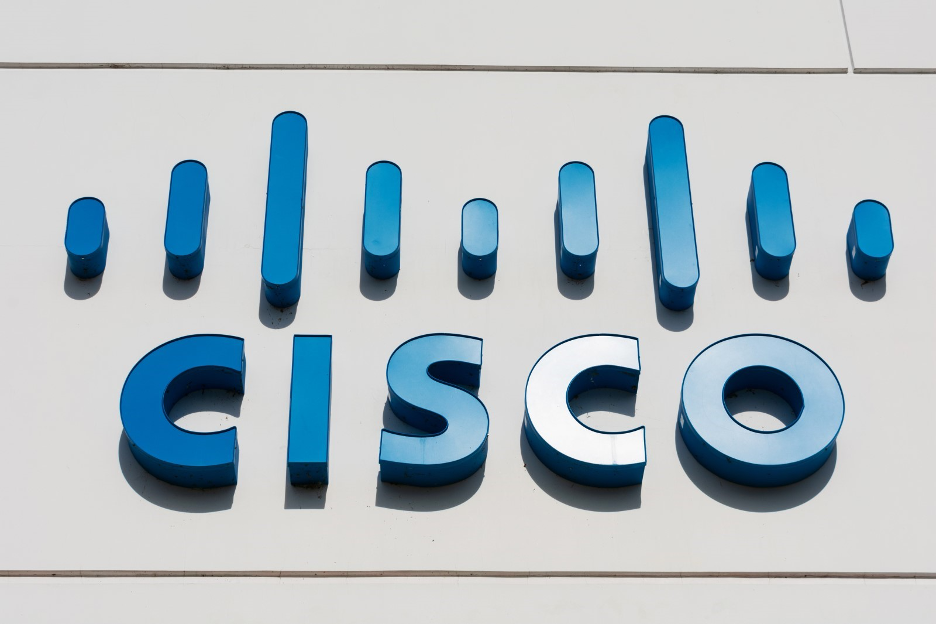
Cisco Systems’ (CSCO) stock declined after it released its Q2 FY2024 earnings report last Wednesday, following market close. Despite beating top- and bottom-line expectations, with results surpassing consensus estimates, the computer networking giant reported lower earnings and revenue compared to the previous year. Cisco’s guidance for the current quarter, ending in April, fell short of expectations.
The company also announced plans to implement another round of cost-cutting layoffs that will affect 5% of its workforce—or about 4,200 jobs.
Here’s an overview of the numbers.
Performance versus Expectations
- Q2 2024 Revenue: $12.8 billion, a 6% decrease YoY (Expected: $12.71 billion)
- Q2 2024 Adjusted EPS: $0.87, a decrease of 1% YoY (Expected: $0.84)
Other Key Q2 2024 Numbers
- $12.8 billion total revenue breakdown:
- Product revenue $9.23 billion, down 9% YoY.
- Service revenue $3.56 billion, up 4% YoY.
- Collaboration revenues increased 3% YoY to $989 million.
- Networking revenues declined 12% YoY to $7.08 billion.
- Security revenues increased 3% YoY to $979 million.
- Observability revenues increased 16% YoY to $188 million.
Analyst Notes
Cisco faces a combination of financial, market, and operational pressures following its latest earnings report. On the earnings call, Cisco chairman and CEO Chuck Robbins attributed some business challenges to delayed customer deployment of products in fiscal year 2024. This delay, stemming from COVID-related supply chain disruptions, particularly impacts enterprise, service provider, and cloud provider customers, who now grapple with what Robbins estimates is more than 20 weeks of excess inventory. Robbins said the delays in deployment timelines are mostly among telco and cable network operators. Overall economic uncertainty and geopolitical factors, such as increased sea freight costs stemming from Red Sea avoidance, further complicate Cisco’s business outlook.
On a positive note, Q2 was a strong quarter for Cisco’s video device businesses. The company continues to push ahead in that area as its customers invest in technologies such as contact centers, where Cisco can help them improve customer experience. Cisco’s collaboration portfolio rose 3%, eclipsing its Q1 growth rate, and Webex saw growth for the second consecutive quarter, following four quarters of decline.
Cisco’s AI strategy is a central focus for its collaboration offerings. The company recently announced a new Webex AI Assistant, an AI-powered codec, and real-time media models. Webex AI Assistant is integrated natively with Cisco Collaboration devices and covers the entire Webex product line. The AI Assistant also suggests responses for contact center agents based on contextual history and surrounding intelligence about customer accounts. Webex Messaging and Slido, Cisco’s meeting Q&A and polling platform, have new GAI features that can tailor message tone, format, and phrasing based on users’ prompts.
Observability remains a bright spot for the company, even though it is the smallest of the divisions for which Cisco reports revenue. Cisco’s focus on observability in communications contributes to better security, efficient IT operations, and the delivery of positive digital experiences.
With the Splunk acquisition, Cisco further expands its observability offerings to give organizations a comprehensive view of their data, incorporating information from Cisco’s network devices and additional security tools. Splunk and Cisco combine Splunk’s SIEM product, which leverages machine-generated data to discern threats, vulnerabilities, and security details, with Cisco’s Extended Detection and Response (XDR) system. Splunk’s proficiency in the SIEM market, particularly in tracking data and log files, strengthens Cisco’s security defense posture. You can read more about how Cisco is tripling down on observability with the Splunk acquisition in this Moor Insights & Strategy research note.
The acquisition of Splunk should close in the second quarter of the 2024 calendar year—a quarter ahead of schedule. On the earnings call, Cisco said it expected the Splunk acquisition to add $4 billion in incremental ARR.
Cisco leadership remains optimistic—and grounded in reality. “We delivered a solid second quarter with strong operating leverage and capital returns,” Robbins said. “We continue to align our investments to future growth opportunities. Our innovation sits at the center of an increasingly connected ecosystem and will play a critical role as our customers adopt AI and secure their organizations.”
Cisco’s Pressures
- Customers are still implementing orders received after Cisco addressed its substantial supply chain backlog.
- Hewlett Packard Enterprises’ (HPE) acquisition of Juniper Networks (JNPR) could disrupt the networking landscape and make HPE a stronger, more direct competitor to Cisco.
- Enterprise adoption of AI workloads is still in the early stages. Cisco must manage investor expectations about how it will monetize AI, which extends to the results of its partnership with NVIDIA (NVDA).
- Connected with the layoffs it has announced, the company expects to incur approximately $800 million in restructuring expenses, primarily related to severance and one-time termination benefits. Most of the cost will occur in Q3 FY2024, with some extending into the first half of FY2025.
Looking Forward
Cisco lowered its annual revenue expectations for the second consecutive quarter. The company set its full-year 2024 revenue guidance at $51.5 to $52.5 billion and full-year non-GAAP EPS at $3.68 to $3.74. The company issued guidance for Q3 FY2024 revenue at $12.1 to $12.3 billion. Non-GAAP EPS guidance for Q3 (ending April 2024) is estimated at $0.84 to $0.86. It is worth noting that Cisco did not include any impact from the Splunk acquisition in its forward-looking guidance.
Robbins ended his portion of the earnings call with three key takeaways: “First, we have reset our expectations for the second half of the year given the cautious macro environment, our customers absorbing high levels of inventory, and ongoing weakness in [the] service provider [space],” he said, explaining the lower-than-expected guidance.
“Second, you can count on us to take a disciplined approach regardless of the environment. We remain committed to operating leverage, capital allocation, and expense management,” Robbins added. “Lastly, our portfolio continues to get stronger and stronger every day. While we have work in front of us and despite the current environment, we remain confident in our long-term strategy.”
Moor Insights & Strategy CEO and chief analyst Patrick Moorhead added his take in a post on X (formerly Twitter): “I view this as a momentary blip, especially for [service providers]. The cross-cloud capabilities the company is building and buying are exciting, differentiated, and don’t rely as much on hardware,” Moorhead said.
Cisco is strategically growing its ARR by focusing on customer success and product adoption—converting that adoption into renewed subscriptions. The strategy has yielded positive results, especially in software-heavy segments such as collaboration and observability.
In collaboration, Cisco continues to build up its Webex video conferencing platform to compete with the likes of Microsoft (MSFT), Zoom (ZM), and RingCentral (RNG). It recently acquired Socio Labs to boost Webex events and continues investing in partnerships that elevate the Webex brand among users. For example, the company partnered with Mercedes Benz and other automakers to equip vehicles with Webex Meetings and Calling for work-from-anywhere connected-car experiences. Cisco has also upped its headset game with the Bang & Olufsen Cisco 950 wireless earbuds, marrying a luxury consumer brand with enterprise-grade communication.
Beyond that, Cisco recently announced an increased integration with Apple, bringing Webex meetings to Apple TV 4K and the Apple Watch. This partnership expands connectivity options for Webex users on Apple devices.
Cisco’s focus on collaboration isn’t just about improving its marketing messaging, although the company has acknowledged this as a priority. Instead, it’s about creating a better approach to hybrid work. While Cisco’s “Make the office a magnet, not a mandate” slogan may be overused and tired, it represents only one part of its overall strategy. Despite the clichéd language, Cisco has executed this aspect of its plan well.
I would like to see the company focus more on hybrid or fully remote workers and their individual experiences beyond meeting rooms. Whether employees are in the office, at home, or on the road, if Cisco can execute its Webex AI strategy and deliver great “from anywhere” devices and experiences, I think we’ll see continued quarters of growth in Collaboration revenue.
Related Recent MI&S Cisco Research
The Six Five team discusses Cisco Q2 FY2024 Earnings podcast excerpt by Patrick Moorhead — February 20, 2024
Cisco Live EMEA 2024 Observability, Networking, and Security Announcements — by Will Townsend and Patrick Moorhead — February 8, 2024
Cisco Partner Summit 2023 Highlights Observability, Security and Sustainability — by Will Townsend and Patrick Moorhead — December 5, 2023
Cisco Triples Down On Observability With Splunk Acquisition — by Will Townsend and Patrick Moorhead — November 13, 2023
Splunk Addresses Upcoming Banking Regulations For Trade Settlement Cycle With Observability Preparation — by Melody Brue, Will Townsend, and Patrick Moorhead — September 13, 2023
Microsoft, Cisco, Adobe, and More Bring Generative AI At Work to Where Work Is Done — by Melody Brue and Patrick Moorhead — June 22, 2023
Mercedes Benz AG Drives Remote Work And Collaboration With Webex By Cisco — by Melody Brue and Patrick Moorhead — April 14, 2023
Note: Moor Insights & Strategy analysts Patrick Moorhead, Will Townsend, and Robert Kramer contributed to this analysis.























































































